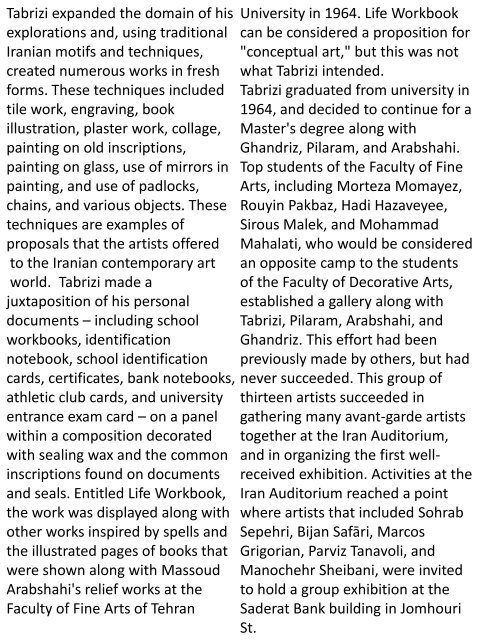Aziz Art Nov2015
History of art(west and Iranian)-contemporary art
History of art(west and Iranian)-contemporary art
Create successful ePaper yourself
Turn your PDF publications into a flip-book with our unique Google optimized e-Paper software.
Tabrizi expanded the domain of his<br />
explorations and, using traditional<br />
Iranian motifs and techniques,<br />
created numerous works in fresh<br />
forms. These techniques included<br />
tile work, engraving, book<br />
illustration, plaster work, collage,<br />
painting on old inscriptions,<br />
painting on glass, use of mirrors in<br />
painting, and use of padlocks,<br />
chains, and various objects. These<br />
techniques are examples of<br />
proposals that the artists offered<br />
to the Iranian contemporary art<br />
world. Tabrizi made a<br />
juxtaposition of his personal<br />
documents – including school<br />
workbooks, identification<br />
notebook, school identification<br />
cards, certificates, bank notebooks,<br />
athletic club cards, and university<br />
entrance exam card – on a panel<br />
within a composition decorated<br />
with sealing wax and the common<br />
inscriptions found on documents<br />
and seals. Entitled Life Workbook,<br />
the work was displayed along with<br />
other works inspired by spells and<br />
the illustrated pages of books that<br />
were shown along with Massoud<br />
Arabshahi's relief works at the<br />
Faculty of Fine <strong>Art</strong>s of Tehran<br />
University in 1964. Life Workbook<br />
can be considered a proposition for<br />
"conceptual art," but this was not<br />
what Tabrizi intended.<br />
Tabrizi graduated from university in<br />
1964, and decided to continue for a<br />
Master's degree along with<br />
Ghandriz, Pilaram, and Arabshahi.<br />
Top students of the Faculty of Fine<br />
<strong>Art</strong>s, including Morteza Momayez,<br />
Rouyin Pakbaz, Hadi Hazaveyee,<br />
Sirous Malek, and Mohammad<br />
Mahalati, who would be considered<br />
an opposite camp to the students<br />
of the Faculty of Decorative <strong>Art</strong>s,<br />
established a gallery along with<br />
Tabrizi, Pilaram, Arabshahi, and<br />
Ghandriz. This effort had been<br />
previously made by others, but had<br />
never succeeded. This group of<br />
thirteen artists succeeded in<br />
gathering many avant-garde artists<br />
together at the Iran Auditorium,<br />
and in organizing the first wellreceived<br />
exhibition. Activities at the<br />
Iran Auditorium reached a point<br />
where artists that included Sohrab<br />
Sepehri, Bijan Safāri, Marcos<br />
Grigorian, Parviz Tanavoli, and<br />
Manochehr Sheibani, were invited<br />
to hold a group exhibition at the<br />
Saderat Bank building in Jomhouri<br />
St.


















